Hi! After accomplishing the activity based on the choice of a writer as the best children’s literature author/a (for what we had to do some research about their lives and works), I reached to the conclusion that this was a much more motivating way to involve children in literature/reading, than by simply reading a book. I also thought that there should be more ways to do it and, in fact, our activity reminded me a lot of one experience that I carried out during my last training period in Ireland. It was another way of getting closer to it, which I would like to share with you.
I came up with the idea during one of the lessons I was involved, in which pupils of 3rd and 4th year (because it was a rural school some years were mixed) were dealing with some reading. I thought that, during the time that I was a primary school pupil, I did not have many chances to know foreign authors or foreign literary works. So I decided to give that chance to who were my pupils at that time, by introducing the Spanish worldwide known Cervantes and its Quixote to them. The teacher was very excited because, as she told me, it was very likely that pupils will have to read it at high-school. So I putted my shoulders to the wheel.
Although I would have preferred pupils to be the ones who look for the information about the concrete author and his works, due to the fact that I did not have much time to develop the activity, I felt somehow a little bit forced to be the one who presented them that information. For doing it, with the help of the Ministry of Education and Universities of the Principality of Asturias’ webpage, I designed two highly visual presentations. In the first one, I included representative and noteworthy data about the author: the city where he was born, the fact that he participated in a war, or that he was in prison.
The second one was about The Quixote: the main characters, the main idea about the different adventures the Quixote lives throughout the whole story, as well as an activity to teach them some words in Spanish.
After that, I showed them a concrete adventure: “The adventure of the windmill” through a video. Because the story was originally narrated in Spanish I previously took out the sound, created a script, and then two of the pupils act as Don Quixote and Sancho Panza. They have lot of fun.
I wished to end the lesson with a meaningful activity for the pupils, so I proposed them the creation of their own Quixote book, by writing, illustrating or both, other adventures that he could have had. They seemed delighted with the idea, and it works much better than what I would have never expected! The interest, creativity and effort that the children demonstrated were spectacular, and the outcome was simply amazing. I was really proud of them ![]()
Some examples of their stories/illustrations are the following ones:
They were really engaged with the activities of the whole lesson and, according with what they told me, they enjoyed so much the experience.
Do you think it was a good idea? Are there any changes you will apply? Does it wake up some ideas for your future activities? I’m looking forward to your answers. Thanks a million!
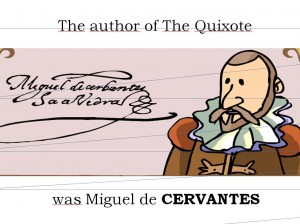
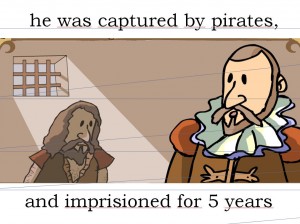
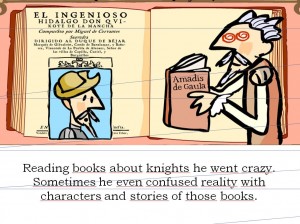
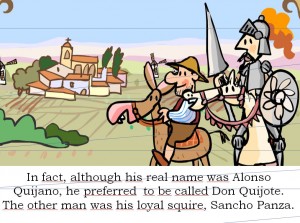

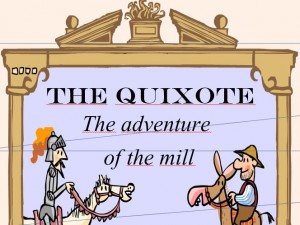
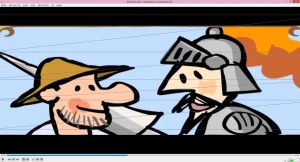
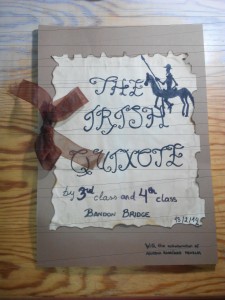
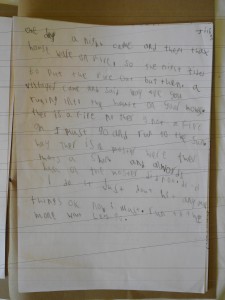
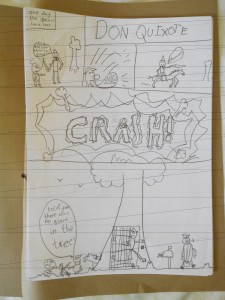
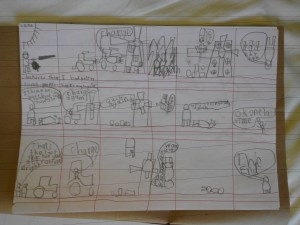

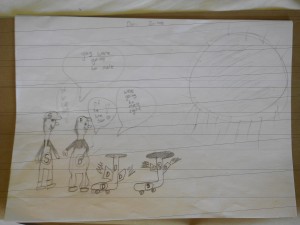
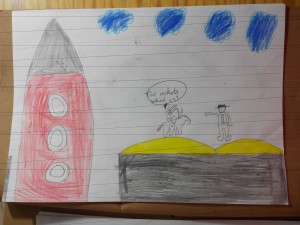
Hi Azu! First of all, I would like to tell you that I wish I would be with you that day when you presented the Quixote. It sounds amazing the presentations and the activities you created for your students. I think this was a very good way to presented them the story, because you encourage them to pay attention and being involved in the story, surprising them with all the things you did.
I completely agree with you, that probably making them looking for information about the Quixote and Cervantes, will motivate them a little bit more; however I´m sure they were so involved to create new adventures for don Quixote and Sancho Panza and the book looks very nice.
Another option of presenting the author and its work it could have been by “sending” them a letter from Cervantes and creating a little box with some objects and materials to use in the presentation and in the different activities you develop in class. I know that this it´s a bit difficult because probably you don´t arranged for materials to fill the box but you could also tell them that to reply Cervantes they should create for example a sword, a shield and some other materials that don Quixote uses and also he wears.
To finish, I would like to say thanks to you because you gave great ideas to present authors and their works to our future students.
Hi Paula! Before anything else I want to thank you for your lovely comment. For me it would have also been a pleasure to have had you there with me. The truth is that, apart from being a worldwide known masterpiece, the Quixote has a very special meaning for me because I knew it thanks to a person which is highly significant for me, my grandfather. Due to that fact, and because I think that (sometimes) the first impression of something is crucial, I tried to do my best at the time of presenting this work to the pupils.
Finally I would also like to thank you for the activity you told me. I think it’s great! Who is not going to feel motivated at the time of receiveng a letter from someone so famous? In fact, during last year subject about Art, I did something similar in the project which aim was to make students get closer to a concrete artist! Millions of thanks for reminding it to me!.
Good morning Azu!
I would like to tell you that I totally agree with your idea of introducing not just the national authors, but also the authors and works of all around the world and belonging to different historical times; especially to promote the reading at school, as I consider that the more you get deeper in the whole reading world, the more you love reading.
Based on my experience, I had the great chance of studying Universal Literature in my highschool and, sincerely, I wish I would have studied those contents before in my life. Along the year, we learnt about the different epochs, their characteristics, and their representative authors, going deeper in their personal life and experiences, their works, etc. and, sometimes, we analysed a text written by them to find the hidden purpose they were trying to transmit and how the author expressed it through their way of writing and the use of different literary resources (which were normally those corresponding to the epoch). So, each lesson opened me a wider range of opportunities to discover and enjoy the authors, their surprising lives and the characters and interesting stories of their books; and I am sure that every kid would love to enjoy the learning of them too.
On the other hand, regarding the project you developed, I would like to tell you that I love it and that I am sure that the students learnt and enjoyed a lot. You presented the contents in a very visually attractive way and perfectly adapted to their age with a good summary, highlighting the key ideas about Cervantes and Don Quixote.
I consider that every literary work, even from Classical Literature, can be offered to children. For example, if we analyse Don Quixote, it is a book about the crazy adventures of a knight, accompanied by a fun character, Sancho Panza, and who is in love with a special lady. This is very similar to other children stories such as Shrek, isn’t it?…
Then, as you did, and what we, as teachers, should do is finding a good way to let the students meet the authors and works by adapting them to the kids’ age; so that they can enter many worlds and enjoy thousands of stories, at the same time they learn from the historical epoques and the authors’ life. Moreover, the students can realise that every author was a normal person like them who decided to use their imagination and creativity to write adventures; concluding that everybody can be part of Literature with a bit of positive attitude and inspiration.
Finally, and related to this last idea of becoming authors, I would like to emphasise the activity of creating their own book. As I explain some weeks before in my post, when I was a child I used to go to the library where we carried out a game of producing books by playing with single worlds and creating a story. I believe that both your activity and the one I played at the library are great for the promotion of reading, and also for fostering creativity, working in groups and other social abilities, linguistic and artistic skills, and furthermore the satisfaction of having your own book “published” and read by other people.
Thank your for sharing your great project with us!
Rocío, I didn’t forget you! It was just that I couldn’t find an appropriate moment to answer you. But here it is
It was just that I couldn’t find an appropriate moment to answer you. But here it is 
Wow Rocío! Millions of thanks for your AMAZING comment! I even don’t know how to start answering you because I agree with you in thousand of things! I will try to go little by little
Firstly, I couldn’t agree with you more in the fact that introducing international, and not just national authors, has an amazing number of advantages, as allowing/helping students to be open-minded in relation with other and different cultures.
You are also absolutely right, when you say that “the more you get deeper in the whole reading world, the more you love reading”. In fact, I could experience so a few days ago, when we presented our authors to the rest of the class. Lots of them really piques my curiosity.
Furthermore, I would like to tell you that although I didn’t have the chance to study the subject you mentioned, because of the wonderful things you say about it, I think that if I had had the opportunity of studying it I would have loved it too.
According with the way of dealing with it, as I was saying to Paula in a few lines above, sometimes first impressions have a strong influence on us, and because this work has a very special meaning for me (my grandfather introduced it to me), I thought a lot about an appropriate and successful way of presenting it to the pupils.
On the other hand, it is true! I didn’t think about the similarity with Shrek until you told me, and the truth is that you are totally right! They share lots of similarities! And I consider that it would be fantastic to show this link to the pupils in order to make them fell more motivated and interested about it.
Finally, many thanks for sharing your great experience about creating books in a library! I think that it could be a fantastic activity which in fact is not very difficult to prepare and carry out, so teachers and future teachers… you do not have excuses for not using it!